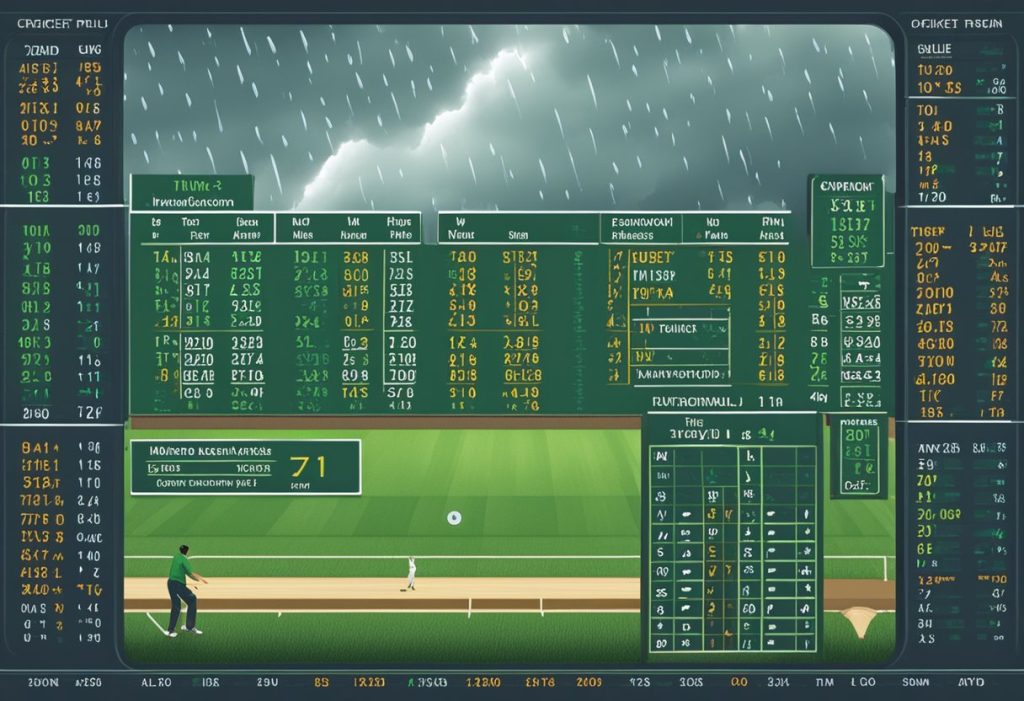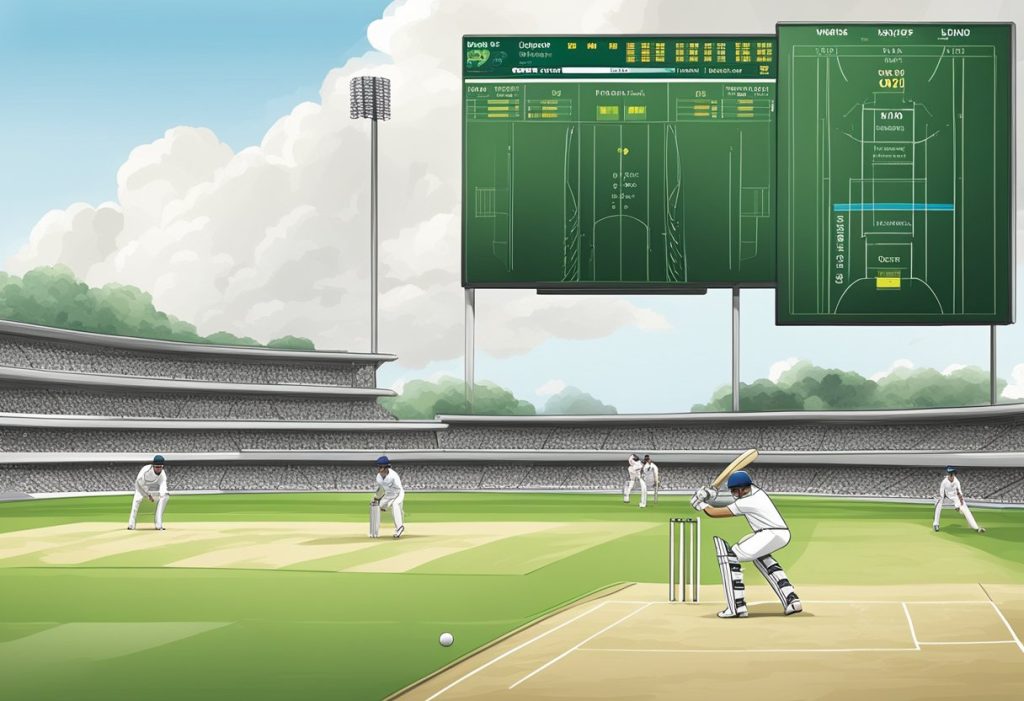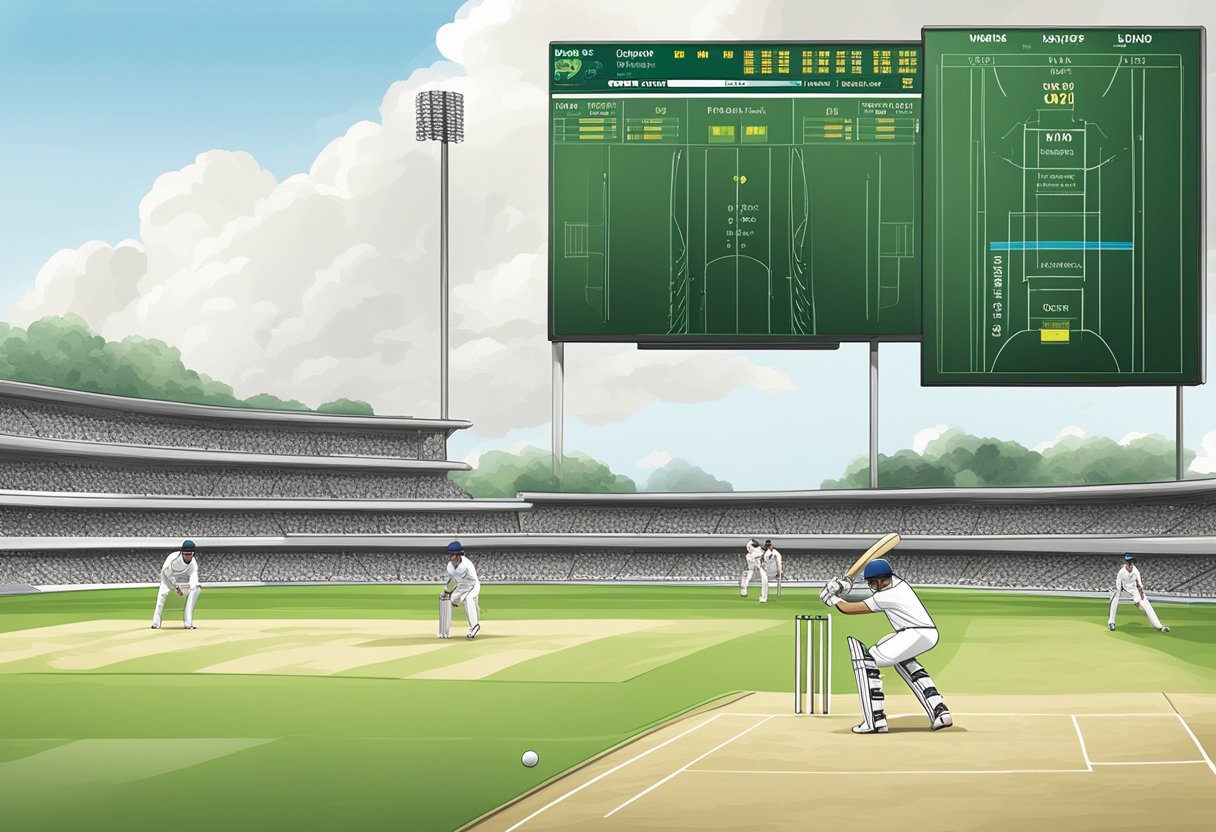Cricket is a sport that is loved and played by millions of people all around the world. It is a game full of uncertainties, and one of the biggest uncertainties is the weather. Rain can disrupt a cricket match, and it can be challenging to determine the winner of the game in such situations. This is where the VJD method comes into play.

The VJD method is a system that is used to calculate target scores in rain-affected one-day and T20 matches in all Indian domestic tournaments. It is an alternative to the Duckworth-Lewis-Stern (DLS) method, the most commonly used method for calculating target scores in rain-affected cricket matches. The VJD method was devised by V. Jayadevan, an Indian engineer from Kerala, was first approved by the Board of Control for Cricket in India (BCCI) in September 2007.
The VJD method is built around two curves, with the first curve depicting the “normal” run-getting pattern when no interruption and the second curve depicting the target run rate for the team batting second in a rain-interrupted game. The method considers the resources available to the team batting second, such as the number of wickets lost and the number of overs remaining. The VJD method has been used in several domestic tournaments in India, and some other cricket leagues worldwide have adopted it.
Overview of the VJD Method
The VJD method is a mathematical formula to calculate target scores in rain-affected one-day and T20 cricket matches. It is an alternative to the Duckworth-Lewis-Stern (DLS) method, another formula used for the same purpose. V. Jayadevan, an Indian engineer from Kerala, devised the VJD method.
The VJD method considers various factors, such as the number of overs played, the number of wickets lost, and the run rate at the time of the interruption. It also considers the resources available to the team batting second, such as the number of overs remaining and wickets in hand.
One of the advantages of the VJD method over the DLS method is that it is less complex and easier to understand. The VJD method also aims to provide a fairer target score in rain-affected matches.
The VJD method has been approved by the Board of Control for Cricket in India (BCCI) for use in all limited-overs domestic matches in India. It has also been used in domestic cricket leagues, such as the Tamil Nadu Premier League.
Overall, the VJD method provides an alternative to the DLS method for calculating target scores in rain-affected cricket matches. It considers various factors and aims to provide a fairer target score for the team batting second.
History of the VJD Method
The VJD Method is a statistical method used in cricket to calculate target scores in rain-affected limited-overs matches. It was devised by V. Jayadevan, an Indian engineer from Kerala, as an alternative to the Duckworth-Lewis-Stern (DLS) method.
Jayadevan’s system aims to address perceived weaknesses in the DLS method, which was introduced in the mid-1990s to replace the previous rain rule, the Average Run Rate (ARR) method. The DLS method has been criticized for being too complicated and not always producing fair results.
The VJD Method was first used in a domestic match in India in 2007, and it has since been used in several domestic tournaments in India, including the Ranji Trophy, the Vijay Hazare Trophy, and the Syed Mushtaq Ali Trophy.
The VJD Method gained wider attention in 2019 when it was used in the final of the Vijay Hazare Trophy between Tamil Nadu and Karnataka. The match was interrupted by rain, and the VJD Method was used to calculate the revised target for Tamil Nadu, who went on to win the game.
Since then, the VJD Method has been used in several other high-profile matches, including the final of the 2021 Indian Premier League (IPL) between the Chennai Super Kings and the Kolkata Knight Riders.
Despite its growing popularity, the VJD Method is not yet widely used outside of India. However, it has been praised by some cricket experts for its simplicity and accuracy, and it may continue to gain traction as an alternative to the DLS method in the future.
Comparison with the Duckworth-Lewis Method

Basic Principles of Duckworth-Lewis
The Duckworth-Lewis (D/L) method is a mathematical formula used to calculate the target score for the team batting second in a limited-overs cricket match that has been interrupted by rain or other circumstances. The D/L method takes into account the number of overs that have been bowled, the number of wickets that have been lost, and the run rate of the team batting first. The target score is then adjusted based on the number of overs that the team batting second has to chase the target.
Advantages of the VJD Method
The V Jayadevan (VJD) method is an alternative to the D/L method for calculating target scores in rain-affected limited-overs cricket matches. The VJD method was developed by V. Jayadevan, an Indian engineer, and is based on a different set of principles than the D/L method. The VJD method takes into account the number of overs that have been bowled, the number of wickets that have been lost, the current run rate of the team batting first, and the resources that are available to the team batting second.
One of the advantages of the VJD method is that it is more responsive to changes in the game than the D/L method. This means that the VJD method can provide more accurate target scores in situations where the game has been affected by rain or other circumstances. The VJD method is also more transparent than the D/L method, as the formula used to calculate the target score is publicly available.
Criticisms and Limitations
Despite its advantages, the VJD method has been criticized for being too complex and difficult to understand. Some cricket experts have also questioned the accuracy of the VJD method, particularly in situations where the game has been affected by multiple rain interruptions.
Another limitation of the VJD method is that it is not widely used in international cricket. The D/L method is the preferred method for calculating target scores in most international cricket matches, and the International Cricket Council (ICC) has not yet adopted the VJD method as an alternative.
Overall, both the D/L method and the VJD method have their advantages and limitations. While the D/L method is more widely used and accepted in international cricket, the VJD method may provide more accurate target scores in certain situations.
Mathematical Foundation of the VJD Method
The VJD method is a mathematical formula that calculates the target score for the team batting second in a rain-affected limited-overs cricket match. The technique was devised by V. Jayadevan, an Indian engineer, as an alternative to the DLS (Duckworth–Lewis–Stern) method.
The VJD method is based on two mathematical curves: the normal score curve and the target score curve. The normal score curve is a parabolic curve that represents the scoring pattern of a team in a normal match. The target score curve is a straight line that represents the required run rate for the team batting second to win the match.
The VJD method takes into account the percentage of runs scored and overs bowled at different phases of the innings. The method uses a complex mathematical formula to calculate the target score based on the number of overs lost due to rain, the number of wickets lost, and the current run rate of the team batting second.
One of the advantages of the VJD method over the DLS method is that it is more responsive to changes in the game situation. The VJD method takes into account the fact that the required run rate for the team batting second changes as the match progresses. This means that the target score calculated by the VJD method is more accurate and fairer for both teams.
In summary, the VJD method is a complex mathematical formula that takes into account the scoring pattern of a team in a normal match and uses this information to calculate the target score for the team batting second in a rain-affected limited-overs cricket match. The method is more responsive than the DLS method and provides a fairer outcome for both teams.
Application in Cricket Matches

The VJD method is commonly used in cricket matches that are affected by rain or other interruptions. This method is used to calculate the revised target scores for the team batting second. The VJD method is an alternative to the DLS (Duckworth-Lewis and Stern) method, which is also used to calculate revised target scores in rain-affected matches.
Domestic Cricket
The VJD method is widely used in domestic cricket matches in India. In September 2007, the BCCI’s technical committee, under the leadership of Sunil Gavaskar, first approved the VJD method for all the limited-overs domestic matches in India. Since then, the VJD method has been used in various domestic cricket tournaments in India, including the Ranji Trophy, Vijay Hazare Trophy, and Syed Mushtaq Ali Trophy.
International Cricket
The VJD method is not yet used in international cricket matches sanctioned by the International Cricket Council (ICC). However, the method has been used in some international cricket matches that are not sanctioned by the ICC, such as the Indian Cricket League (ICL). The VJD method has also been adopted by some cricket boards in other countries, such as South Africa and Sri Lanka.
The VJD method has gained popularity among cricket fans and experts due to its simplicity and accuracy in calculating revised target scores in rain-affected matches. The process takes into account various factors, such as the number of overs remaining, the number of wickets lost, and the run rate required to win the match. Overall, the VJD method has proven to be a reliable and effective method for calculating revised target scores in cricket matches affected by rain or other interruptions.
Controversies Surrounding the VJD Method
The VJD method has been a subject of controversy since its introduction. One of the main criticisms is that it is too complex and difficult to understand. The D/L method, which was previously used to calculate target scores in rain-affected matches, is considered to be simpler and easier to understand.
Another criticism of the VJD method is that it is not universally accepted. While it is used in some domestic cricket tournaments in India, it is not used in international cricket. This has led to confusion and inconsistency in the way target scores are calculated in different matches.
There have also been concerns about the accuracy of the VJD method. Some experts have argued that it does not take into account all the factors that can affect the outcome of a match, such as the quality of the pitch, the strength of the teams, and the skill of the players.
Despite these criticisms, supporters of the VJD method argue that it is a more accurate and fairer way of calculating target scores in rain-affected matches. They point out that it takes into account more variables than the D/L method and is therefore more precise.
In conclusion, while there are controversies surrounding the VJD method, it remains a popular and widely used method for calculating target scores in rain-affected matches in domestic cricket tournaments in India.
Future of the VJD Method in Cricket
The VJD method has been a subject of controversy since its introduction. One of the main criticisms is that it is too complex and difficult to understand. The D/L method, which was previously used to calculate target scores in rain-affected matches, is considered to be simpler and easier to understand.
Another criticism of the VJD method is that it is not universally accepted. While it is used in some domestic cricket tournaments in India, it is not used in international cricket. This has led to confusion and inconsistency in the way target scores are calculated in different matches.
There have also been concerns about the accuracy of the VJD method. Some experts have argued that it does not take into account all the factors that can affect the outcome of a match, such as the quality of the pitch, the strength of the teams, and the skill of the players.
Despite these criticisms, supporters of the VJD method argue that it is a more accurate and fairer way of calculating target scores in rain-affected matches. They point out that it takes into account more variables than the D/L method and is, therefore, more precise.
In conclusion, while there are controversies surrounding the VJD method, it remains a popular and widely used method for calculating target scores in rain-affected matches in domestic cricket tournaments in India.
Frequently Asked Questions
- How does the VJD method determine target scores in cricket?
The VJD method uses a mathematical formula to set target scores in rain-affected cricket matches. It considers the number of lost overs, the current score of the batting team, and the available resources for both teams. This method aims to provide a more accurate target than the DLS method, especially when the second team has fewer overs to chase.
- What are the key differences between the VJD and DLS methods?
The VJD and DLS methods calculate target scores in interrupted cricket matches but differ in approach. The VJD method considers lost overs, the batting team’s current score, and available resources. In contrast, the DLS method uses a more complex formula, factoring in the batting team’s run rate, lost wickets, and remaining overs.
- Can you explain the VJD method with a practical example?
Imagine a cricket match scheduled for 50 overs per side, but rain reduces it to 40 overs each. The first team scores 250 runs in their 40 overs. Under the VJD method, the second team gets a revised target of 267 runs in their 40 overs. This adjustment accounts for the lost overs, the first team’s score, and the resources available to both teams.
- Is the VJD method used in T20 cricket, and if so, how?
Yes, the VJD method is used in T20 cricket for rain-affected matches. It operates similarly to one-day matches, adjusting for lost overs, the batting team’s current score, and available resources to set a fair target for the second team.
- How is the VJD method calculated in interrupted cricket matches?
The VJD method calculates revised targets using a formula that includes the number of lost overs, the current score of the batting team, and the resources available to both teams. This method aims to provide a fairer target than the DLS method, especially when the second team has fewer overs to bat.
- Where can I find detailed documentation on the VJD method?
You can find detailed documentation on the VJD method on the official website of its creator, V. Jayadevan. The BCCI also provides information on the method, as they have approved its use for all limited-overs domestic matches in India.

I am Manan Joshi , SEO All-Rounder at CricHeroes.
CricHeroes is the ultimate Cricket Scoring App and the world’s only true Cricket Network. With more than 4 crore+ registered cricketers using CricHeroes to Live Cricket Scores for their local cricket matches and tournaments, CricHeroes is already the #1 Cricket Scoring App Globally!
We also proudly present “CricHeroes Store” by CricHeroes, a dedicated shop for cricket apparel and accessories, helping players gear up for their game.















